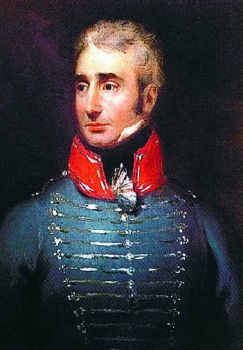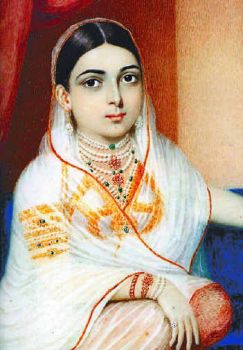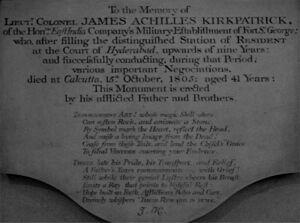James Achilles Kirkpatrick facts for kids
Quick facts for kids
James Achilles Kirkpatrick
|
|
|---|---|

James Achilles Kirkpatrick, an oil painting by George Chinnery, c. 1805.
|
|
| Born | 1764 Fort St. George, Madras, India
|
| Died | 15 October 1805 Calcutta, India
|
| Nationality | British |
| Occupation | Lieutenant-Colonel Resident at Hyderabad |
| Known for | Built the historic Koti Residency in Hyderabad, a landmark and major tourist attraction. Documented interracial love affair and marriage between him and Indian noblewoman Khair-un-Nissa Begum. |
| Spouse(s) | Khair-un-Nissa |
| Children | Kitty Kirkpatrick William Kirkpatrick |
| Parent(s) |
|
Lieutenant-Colonel James Achilles Kirkpatrick (1764 – 15 October 1805) was a British officer and diplomat. He worked for the East India Company, a powerful trading company. From 1798 to 1805, he served as the British Resident in Hyderabad Deccan. A Resident was like an ambassador or a special representative. Kirkpatrick also ordered the building of the Koti Residency in Hyderabad. This building is now a famous landmark and a popular place for tourists.
Contents
Life of James Kirkpatrick
James Achilles Kirkpatrick was born in 1764 in Fort St George, Madras, India. He took over the role of Resident in Hyderabad in 1795, replacing his brother William.
Adapting to Indian Culture
When James first arrived in Hyderabad, he was very interested in the local Indo-Persian culture. This culture was part of the court of the Nizam of Hyderabad, who was the ruler. James started wearing Persian clothes instead of his usual European outfits.
Even though he was a colonel in the British army, Kirkpatrick lived a life that blended British and Mughal traditions. He wore Mughal-style clothes at home. He also smoked a hookah (a type of water pipe) and chewed betelnut. He enjoyed nautch parties, which were performances with music and dancing.
Kirkpatrick was born in India and spoke Tamil as his first language. He later learned Persian and Hindustani. He even wrote poetry in Urdu. His language skills helped him connect with the important people in Hyderabad.
Special Titles and Friends
The Nizam of Hyderabad thought highly of Kirkpatrick. The Nizam even adopted him and gave him several special titles. These titles included mutamin ul mulk (meaning 'Safeguard of the kingdom') and hushmat jung (meaning 'Valiant in battle'). He was also called nawab fakhr-ud-dowlah bahadur ('Governor, pride of the state, and hero').
There's a story from the time of King George III about Kirkpatrick's hookah-bardar (his servant who prepared his hookah). This servant supposedly tricked Kirkpatrick and then traveled to England. There, he pretended to be the Prince of Sylhet. He even met important people like the Prime Minister William Pitt the Younger, the Duke of York, and even the King himself.
Kirkpatrick's Marriage
In 1800, James Kirkpatrick fell in love with a local Hyderabadi noblewoman named Khair-un-Nissa. She was a Sayyida, meaning she came from a respected family. Kirkpatrick married her according to Muslim law. He also adopted Mughal clothes and ways of living. Some people even believed he had secretly converted to Islam.
Details of the Marriage
Kirkpatrick and Khair-un-Nissa had a private Muslim wedding ceremony. Khair-un-Nissa was fourteen years old at the time, which was a common age for girls of her social class to marry. She was the granddaughter of Nawab Mahmood Ali Khan, who was the prime minister of Hyderabad.
The marriage was not officially recorded by British law. In his will, Kirkpatrick showed his deep care for Khair-un-Nissa. He left most of his money to their two children. He mentioned that Khair-un-Nissa already had a large fortune from her father.
Some of Kirkpatrick's Muslim staff and Khair-un-Nissa's family believed he had secretly become a Muslim. They said he received a certificate from a Shi'a Mujtahid (a Muslim cleric).
Challenges and Aftermath
Around 1801, there was a big discussion in Calcutta about Kirkpatrick's actions in Hyderabad. Some people disapproved of his marriage because of the cultural differences.

The way Kirkpatrick worked as Resident was affected by Lord Richard Wellesley. Wellesley became the Governor-General of India. He wanted the British to have more control over the Nizam of Hyderabad. Wellesley also strongly disapproved of Kirkpatrick's marriage to Khair-un-Nissa.
James Kirkpatrick died in Calcutta on 15 October 1805. He was only 41 years old. Khair-un-Nissa was just 19 when he passed away. After his death, she faced difficulties and eventually lost her valuable family estates. She died in Hyderabad on 22 September 1813, at the age of 27.
Their Children
Kirkpatrick and Khair-un-Nissa had two children: a son named Mir Ghulam Ali Sahib Allum and a daughter named Noor-un-Nissa Sahib Begum. Before their father's death, the children were sent to England to live with their grandfather, Colonel James Kirkpatrick. This was a common practice for British families in India at that time.
The children were baptized on 25 March 1805 and received new Christian names. The son became William George Kirkpatrick, and the daughter became Katherine Aurora "Kitty" Kirkpatrick.
William had an accident in 1812 and had to have an arm removed. He later married and had three children, but he died young in 1828 at age 27. Kitty was a friend and inspiration for the Scottish writer and philosopher Thomas Carlyle for a few years. She later married Captain James Winslowe Phillipps and they had seven children. Kitty lived a long life and died in Torquay, Devon, in 1889.
In Popular Culture
A large part of the book White Mughals by historian William Dalrymple tells the story of Kirkpatrick's relationship with Khair-un-Nissa.


